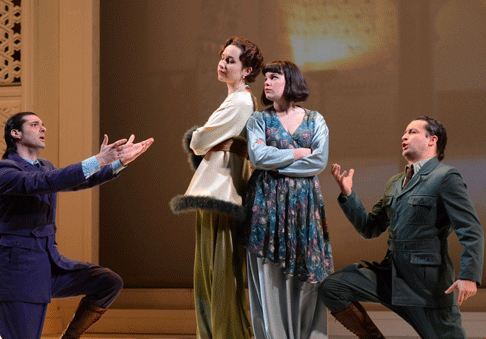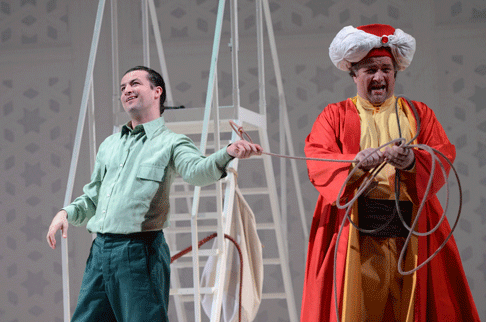06 Mar 2012
Abduction from the Seraglio, Philadelphia
Abduction from the Seraglio contains not a single ironic or cynical moment. Enlightened mercy and sincere love triumph totally over revenge, slavery and tyranny.

Abduction from the Seraglio contains not a single ironic or cynical moment. Enlightened mercy and sincere love triumph totally over revenge, slavery and tyranny.
Despite its robust comedy, technical difficulty, and occasional exoticism, Mozart’s music is youthfully transparent. His fresh score transforms eternal stereotypes—two noble lovers, a spunky English maid with her enthusiastic if naïve boyfriend, and the crude barbarian overseer who would thwart them—into uniquely memorable individuals whose feelings we seem to intuit directly.
This emotional honesty poses a challenge for theater directors, whose attitude toward this work has changed several times in my experience. Until well into the second half of the 20th century (and in provincial performances still), Abduction was presented as a robustly German comic romp. Several generations ago, Giorgio Strehler and others sought to elevate such productions by stripping away tired slapstick routines to reveal the full range and depth of underlying humanist sentiments. Over time, however, most such productions came to focus excessively a stylized dilemma facing Konstanze whether to love Bassa Selim or Belmonte—despite the lack of any textual or musical support for an inner conflict. Over the past decade, the opera has gained new notoriety as the object of Regietheater excess. In search of an underlying social message, Calixto Bieito famously set it as a dystopic story about human trafficking, featuring masturbation, oral sex, urination, and much violence. In a much discussed scene, Osmin hacks up a whore and offers her bloody, severed nipples to Konstanze—an interpretation widely criticized for violating the spirit of Mozart’s music.
Philadelphia’s new production (shared with Treviso) faces the Abduction challenge with a new and intriguing conceit. It resurrects the notion of a “rescue opera”—a popular 18th formula, of which this opera is an example, whereby noble Europeans are saved from oppression and bondage—and seeks to update it with stock characters, styles and settings from silent movies. The Seraglio becomes Constantinople in 1918 (the supertitles anachronistically call it Istanbul), Bassa Selim becomes Ataturk, and Konstanze becomes a British spy seeking to pry secrets from the Turks during World War I. It suggests a fresh set of images, drawn from an era with which a modern audience can better identify, yet also in which individuality, femininity, and the relationship between East and West were being redefined in interesting ways. A promising premise…
 Antonio Lozano as Belmonte, Elizabeth Zharoff as Konstanze, Elizabeth Reiter as Blonde and Krystian Adam as Pedrillo
Antonio Lozano as Belmonte, Elizabeth Zharoff as Konstanze, Elizabeth Reiter as Blonde and Krystian Adam as Pedrillo
Yet the production only skims the surface of the concept, with tame results. By the end of the overture, the spy story disappears (just as well, since Konstanze is no spy). At times the background features a silent movie, but this is applied randomly, rather than being exploited consistently to underscore the action. Surely it would not have been hard to find engaging parallels: Belmonte and Konstanze, as well as Pedrillo and Blonde, do resemble the virtuous couples who inhabit silent films, while Osmin does recall villains like Chaplin’s “Big Eric.” Yet the projections provide little more than local color: generic scenes and, at the end, just a quarter hour shot of an old postcard of Hagia Sofia. Beyond the backdrop, the production is remarkably old-fashioned, even provincial, with overheavy reliance on crude gags, garish costumes, and harem girls. A quarter of an hour in, watching Osmin, clad in bright yellow, chasing Pedrillo with a whip, one acknowledges it will be a long afternoon.
Still, a major advantage of the unconventional “movie screen” set design is its theatrical and acoustical intimacy—a plus in this intimate work. It pushes action to the front of the stage, where two ramps permit the singers to cross through the first row of the audience. Thus the burden rests on the singers to carry the show. Yet here, too, the performance gets stuck half-way. Today there is no shortage of great Baroque and Mozart singers, yet one rarely encounters a major house cast as uneven as this one.
 Krystian Adam is Pedrillo with Per Bach Nissen as Osmin
Krystian Adam is Pedrillo with Per Bach Nissen as Osmin
Young soprano and Curtis student Elizabeth Zharoff possesses a warm, even, and well-placed voice, solid coloratura technique, and considerable innate musicality that could take her far in the opera world—and she looks good on stage. Yet Konstanze is a bit of a stretch. In her mid-20s, Zharoff does not quite yet possess the weight and vocal glamor for showpieces like “Martern aller Arten” or “Ach ich liebte” in a big house. She would be more appropriately cast as Pamina, which she will sing next year in Philadelphia.
Never before have I heard a Belmonte who sounds more comfortable in “Ich baue ganz”—the Act III aria often ducked by even the best tenors due to its daunting technical difficulties—than in the two more famous arias of Act I. Spanish Tenor Antonio Lozano brings many things to the role—a voice of reasonable size, clean passagework, and an ardent manner—but not what the role of Belmonte requires above all else, namely noble phrasing and smoothly elegant vocal production. Uneven color and intonation, as well as Spanish-accented German that seems not that of a speaker (let alone native speaker) of the language, weigh him down musically and theatrically.
Polish tenor Krystian Adam sings and acts superbly in the character role of Pedrillo. The young Curtis grad (now in Frankfurt) Elizabeth Reiter is, as her previous work with Philadelphia has shown, a splendid singer on her way up. She sings with a full tone, compelling phrasing, and precise intonation. Yet she seems vocally uncomfortable as Blöndchen, a role Mozart crafted especially for a soubrette with unusually free high notes. Singers with the dark bass voice for Osmin are an endangered species. Nissen sings Osmin at a solid European provincial level, but lacks a booming low D or any other special attribute for the role, though his diction is the best in the show.
Music director Corrado Rovaris conducts crisply, in a style aimed somewhere between the modern and period, and only occasionally let the ensemble slip. Yet the result is neither idiosyncratic nor idiomatic. One waits in vain for the rubato or graceful turn of phrase that would breathe life into this wonderful score.
Andrew Moravcsik